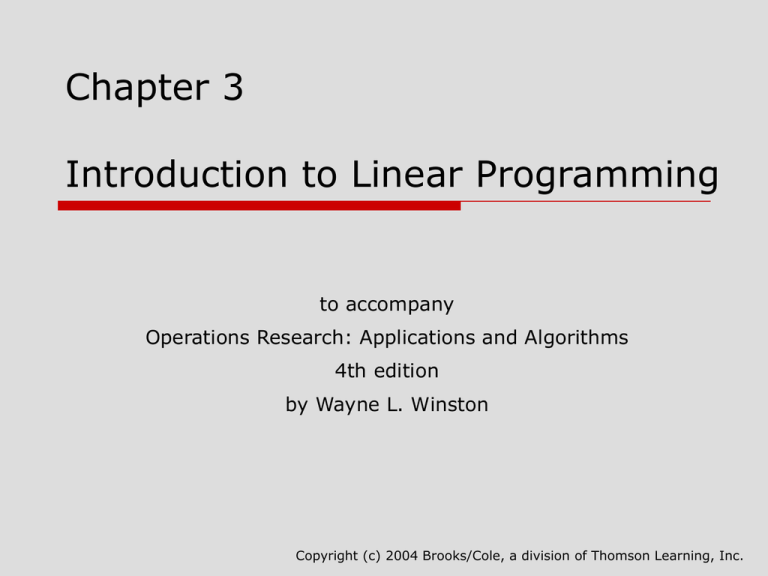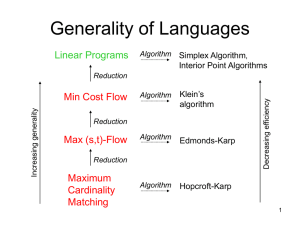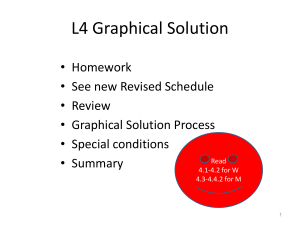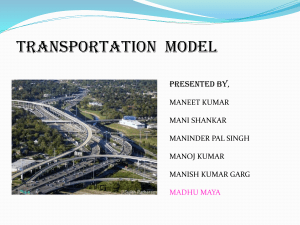Topic 6
advertisement

Chapter 3 Introduction to Linear Programming to accompany Operations Research: Applications and Algorithms 4th edition by Wayne L. Winston Copyright (c) 2004 Brooks/Cole, a division of Thomson Learning, Inc. 3.1 What Is a Linear Programming Problem? Linear Programming (LP) is a tool for solving optimization problems. Linear programming problems involve important terms that are used to describe linear programming. 2 Example 1: Giapetto’s Woodcarving Giapetto’s, Inc., manufactures wooden soldiers and trains. Each soldier built: Sell for $27 and uses $19 worth of raw materials. Increase Giapetto’s variable labor/overhead costs by $14. Requires 2 hours of finishing labor. Requires 1 hour of carpentry labor. Each train built: Sell for $21 and used $9 worth of raw materials. Increases Giapetto’s variable labor/overhead costs by $10. Requires 1 hour of finishing labor. Requires 1 hour of carpentry labor. 3 Ex. 1 - continued Each week Giapetto can obtain: All needed raw material. Only 100 finishing hours. Only 80 carpentry hours. Demand for the trains is unlimited. At most 40 soldiers are bought each week. Giapetto wants to maximize weekly profit (revenues – costs). Formulate a mathematical model of Giapetto’s situation that can be used maximize weekly profit. 4 Example 1: Solution The Giapetto solution model incorporates the characteristics shared by all linear programming problems. Decision variables should completely describe the decisions to be made. x1 = number of soldiers produced each week x2 = number of trains produced each week The decision maker wants to maximize (usually revenue or profit) or minimize (usually costs) some function of the decision variables. This function to maximized or minimized is called the objective function. For the Giapetto problem, fixed costs do not depend upon the the values of x1 or x2. 5 Ex. 1 - Solution continued Giapetto’s weekly profit can be expressed in terms of the decision variables x1 and x2: Weekly profit = weekly revenue – weekly raw material costs – the weekly variable costs = 3x1 + 2x2 Thus, Giapetto’s objective is to chose x1 and x2 to maximize weekly profit. The variable z denotes the objective function value of any LP. Giapetto’s objective function is Maximize z = 3x1 + 2x2 The coefficient of an objective function variable is called an objective function coefficient. 6 Ex. 1 - Solution continued As x1 and x2 increase, Giapetto’s objective function grows larger. For Giapetto, the values of x1 and x2 are limited by the following three restrictions (often called constraints): Each week, no more than 100 hours of finishing time may be used. (2 x1 + x2 ≤ 100) Each week, no more than 80 hours of carpentry time may be used. (x1 + x2 ≤ 80) Because of limited demand, at most 40 soldiers should be produced. (x1 ≤ 40) 7 The coefficients of the decision variables in the constraints are called the technological coefficients. The number on the right-hand side of each constraint is called the constraint’s right-hand side (or rhs). To complete the formulation of a linear programming problem, the following question must be answered for each decision variable. Can the decision variable only assume nonnegative values, or is the decision variable allowed to assume both positive and negative values? If the decision variable can assume only nonnegative values, the sign restriction xi ≥ 0 is added. If the variable can assume both positive and negative values, the decision variable xi is unrestricted in sign (often abbreviated urs). 8 Ex. 1 - Solution continued For the Giapetto problem model, combining the sign restrictions x1≥0 and x2≥0 with the objective function and constraints yields the following optimization model: Max z = 3x1 + 2x2 (objective function) Subject to (s.t.) 2 x1 + x2 ≤ 100 (finishing constraint) x1 + x2 ≤ 80 (carpentry constraint) x1 ≤ 40 (constraint on demand for soldiers) x1 ≥0 (sign restriction) ≥0 (sign restriction) x2 9 A function f(x1, x2, …, xn of x1, x2, …, xn is a linear function if and only if for some set of constants, c1, c2, …, cn, f(x1, x2, …, xn) = c1x1 + c2x2 + … + cnxn. For any linear function f(x1, x2, …, xn) and any number b, the inequalities f(x1, x2, …, xn) ≤ b and f(x1, x2, …, xn) ≥ b are linear inequalities. 10 A linear programming problem (LP) is an optimization problem for which we do the following: Attempt to maximize (or minimize) a linear function (called the objective function) of the decision variables. The values of the decision variables must satisfy a set of constraints. Each constraint must be a linear equation or inequality. A sign restriction is associated with each variable. For any variable xi, the sign restriction specifies either that xi must be nonnegative (xi ≥ 0) or that xi may be unrestricted in sign. 11 The fact that the objective function for an LP must be a linear function of the decision variables has two implications: 1. The contribution of the objective function from each decision variable is proportional to the value of the decision variable. For example, the contribution to the objective function for 4 soldiers is exactly fours times the contribution of 1 soldier. 2. The contribution to the objective function for any variable is independent of the other decision variables. For example, no matter what the value of x2, the manufacture of x1 soldiers will always contribute 3x1 dollars to the objective function. 12 Analogously, the fact that each LP constraint must be a linear inequality or linear equation has two implications: 1. The contribution of each variable to the left-hand side of each constraint is proportional to the value of the variable. For example, it takes exactly 3 times as many finishing hours to manufacture 3 soldiers as it does 1 soldier. 2. The contribution of a variable to the left-hand side of each constraint is independent of the values of the variable. For example, no matter what the value of x1, the manufacture of x2 trains uses x2 finishing hours and x2 carpentry hours 13 The first item in each list is called the Proportionality Assumption of Linear Programming. The second item in each list is called the Additivity Assumption of Linear Programming. The divisibility assumption requires that each decision variable be permitted to assume fractional values. 14 The certainty assumption is that each parameter (objective function coefficients, right-hand side, and technological coefficients) are known with certainty. The feasible region of an LP is the set of all points satisfying all the LP’s constraints and sign restrictions. For a maximization problem, an optimal solution to an LP is a point in the feasible region with the largest objective function value. Similarly, for a minimization problem, an optimal solution is a point in the feasible region with the smallest objective function value. 15 3.2 – The Graphical Solution to a Two-Variable LP Problem Any LP with only two variables can be solved graphically. The variables are always labeled x1 and x2 and the coordinate axes the x1 and x2 axes. X2 4 Satisfies 2x1 + 3x2 ≥ 6 3 2 1 Satisfies 2x1 + 3x2 ≤ 6 X1 -1 1 2 3 4 -1 16 Since the Giapetto LP has two variables, it may be solved graphically. The feasible region is the set of all points satisfying the constraints 2 x1 + x2 ≤ 100 (finishing constraint) x1 + x2 ≤ 80 (carpentry constraint) x1 ≤ 40 (demand constraint) x1 ≥ 0 (sign restriction) x2 ≥ 0 (sign restriction) 17 The set of points satisfying the Giapetto LP is bounded by the five sided polygon DGFEH. Any point on or in the interior of this polygon (the shade area) is in the feasible region. X2 100 B finishing constraint Feasible Region 80 D demand constraint 60 G z = 100 40 carpentry constraint 20 F z = 180 z = 60 E H 10 20 40 A 50 60 C 80 X1 18 Having identified the feasible region for the Giapetto LP, a search can begin for the optimal solution which will be the point in the feasible region with the largest z-value. To find the optimal solution, graph a line on which the points have the same z-value. In a max problem, such a line is called an isoprofit line while in a min problem, this is called the isocost line. The figure shows the isoprofit lines for z = 60, z = 100, and z = 180 Lindo Example 19 A constraint is binding if the left-hand and right-hand side of the constraint are equal when the optimal values of the decision variables are substituted into the constraint. In the Giapetto LP, the finishing and carpentry constraints are binding. A constraint is nonbinding if the left-hand side and the right-hand side of the constraint are unequal when the optimal values of the decision variables are substituted into the constraint. In the Giapetto LP, the demand constraint for wooden soldiers is nonbinding since at the optimal solution (x1 = 20), x1 < 40. 20 A set of points S is a convex set if the line segment jointing any two pairs of points in S is wholly contained in S. For any convex set S, a point p in S is an extreme point if each line segment that lies completely in S and contains the point P has P as an endpoint of the line segment. Extreme points are sometimes called corner points, because if the set S is a polygon, the extreme points will be the vertices, or corners, of the polygon. The feasible region for the Giapetto LP will be a convex set. 21 Example 2 : Dorian Auto Dorian Auto manufactures luxury cars and trucks. The company believes that its most likely customers are high-income women and men. To reach these groups, Dorian Auto has embarked on an ambitious TV advertising campaign and will purchase 1-mimute commercial spots on two type of programs: comedy shows and football games. 22 Ex. 2: continued Each comedy commercial is seen by 7 million high income women and 2 million high-income men and costs $50,000. Each football game is seen by 2 million highincome women and 12 million high-income men and costs $100,000. Dorian Auto would like for commercials to be seen by at least 28 million high-income women and 24 million high-income men. Use LP to determine how Dorian Auto can meet its advertising requirements at minimum cost. 23 Example 2: Solution Dorian must decide how many comedy and football ads should be purchased, so the decision variables are x1 = number of 1-minute comedy ads x2 = number of 1-minute football ads Dorian wants to minimize total advertising cost. Dorian’s objective functions is min z = 50 x1 + 100x2 Dorian faces the following the constraints Commercials must reach at least 28 million high-income women. (7x1 + 2x2 ≥ 28) Commercials must reach at least 24 million high-income men. (2x1 + 12x2 ≥ 24) The sign restrictions are necessary, so x1, x2 ≥ 0. 24 Ex. 2 – Solution continued Like the Giapetto LP, the Dorian LP has a convex feasible region. The feasible region for the Dorian problem, however, contains points for which the value of at least one variable can assume arbitrarily large values. Such a feasible region is called an unbounded feasible region. 25 Ex. 2 – Solution continued To solve this LP graphically begin by graphing the feasible region. X2 14 B High-income women constraint 12 10 Feasible Region (unbounded) 8 6 z = 600 4 z = 320 High-income men constraint 2 E D C A 2 4 6 8 10 12 14 X1 26 Ex. 2 – Solution continued Since Dorian wants to minimize total advertising costs, the optimal solution to the problem is the point in the feasible region with the smallest z value. An isocost line with the smallest z value passes through point E and is the optimal solution at x1 = 3.4 and x2 = 1.4. Both the high-income women and high-income men constraints are satisfied, both constraints are binding. 27 Ex. 2 – Solution continued Does the Dorian model meet the four assumptions of linear programming? The Proportionality Assumption is violated because at a certain point advertising yields diminishing returns. Even though the Additivity Assumption was used in writing: (Total viewers) = (Comedy viewer ads) + (Football ad viewers) many of the same people might view both ads, double-counting of such people would occur thereby violating the assumption. The Divisibility Assumption is violated if only 1minute commercials are available. Dorian is unable to purchase 3.6 comedy and 1.4 football commercials. The Certainty assumption is also violated because there is no way to know with certainty how many viewers are added by each type of commercial. 28 Class Problem – 3.2.6 Farmer Jane owns 45 acres of land. She is going to plant each with wheat or corn. Each acre planted with wheat yields $200 profit, each with corn yields $300 profit. For wheat, each acre takes 3 workers and 2 tons of fertiliser, for corn, each acre takes 2 workers and 4 tons of fertiliser. One hundred workers and 120 tons of fertiliser are available. 29 3.3 Special Cases The Giapetto and Dorian LPs each had a unique optimal solution. Some types of LPs do not have unique solutions. Some LPs have an infinite number of solutions (alternative or multiple optimal solutions). Some LPs have no feasible solutions (infeasible LPs). Some LPs are unbounded: There are points in the feasible region with arbitrarily large (in a maximization problem) z-values. The technique of goal programming is often used to choose among alternative optimal solutions. 30 It is possible for an LP’s feasible region to be empty, resulting in an infeasible LP. Because the optimal solution to an LP is the best point in the feasible region, an infeasible LP has no optimal solution. For a max problem, an unbounded LP occurs if it is possible to find points in the feasible region with arbitrarily large z-values, which corresponds to a decision maker earning arbitrarily large revenues or profits. 31 For a minimization problem, an LP is unbounded if there are points in the feasible region with arbitrarily small zvalues. Every LP with two variables must fall into one of the following four cases. The LP has a unique optimal solution. The LP has alternative or multiple optimal solutions: Two or more extreme points are optimal, and the LP will have an infinite number of optimal solutions. The LP is infeasible: The feasible region contains no points. The LP unbounded: There are points in the feasible region with arbitrarily large z-values (max problem) or arbitrarily small z-values (min problem). Class Problem 32 Example 6: Diet Problem My diet requires that all the food I get come from one of the four “basic food groups”. At present, the following four foods are available for consumption: brownies, chocolate ice cream, cola and pineapple cheesecake. Each brownie costs 50¢, each scoop of ice cream costs 20 ¢, each bottle of cola costs 30 ¢,, and each piece of pineapple cheesecake costs 80 ¢. Each day, I must ingest at least 500 calories, 6 oz of chocolate, 10 oz of sugar, and 8 oz of fat. 33 Ex. 6 - continued The nutritional content per unit of each food is given. Formulate a linear programming model that can be used to satisfy my daily nutritional requirements at minimum cost. 34 Example 6: Solution As always, begin by determining the decisions that must be made by the decision maker: how much of each type of food should be eaten daily. Thus we define the decision variables: x1 = number of brownies eaten daily x2 = number of scoops of chocolate ice cream eaten daily x3 = bottles of cola drunk daily x4 = pieces of pineapple cheesecake eaten daily 35 Ex. 6 – Solution continued My objective is to minimize the cost of my diet. The total cost of any diet may be determined from the following relation: (total cost of diet) = (cost of brownies) + (cost of ice cream) +(cost of cola) + (cost of cheesecake). The decision variables must satisfy the following four constraints: Daily calorie intake must be at least 500 calories. Daily chocolate intake must be at least oz. Daily sugar intake must be at least 10 oz. Daily fat intake must be at least 8 oz. 36 Ex. 6 – Solution continued Express each constraint in terms of the decision variables. The optimal solution to this LP is found by combining the objective functions, constraints, and the sign restrictions. The chocolate and sugar constraints are binding, but the calories and fat constraints are nonbinding. A version of the diet problem with a more realistic list of foods and nutritional requirements was one of the first LPs to be solved by computer. Diet in Lindo 37 3.5 A Work-Scheduling Problem Many applications of linear programming involve determining the minimum-cost method for satisfying workforce requirements. The results may be different solved manually versus using LINDO, LINGO or Excel Solver. One type of work scheduling problem is a static scheduling problem. In reality, demands change over time, workers take vacations in the summer, and so on, so the post office does not face the same situation each week. This is a dynamic scheduling problem. 38 3.6 A Capital Budgeting Problem Linear programming can be used to determine optimal financial decisions. The concept of net present value (NPV) can be used to compare the desirability of different investments. The total value of the cash flows for any investment is called by net present value, or NPV, of the investment. The NPV of an investment is the amount by which the investment will increase the form’s value. 39 The Excel =NPV function makes this computation easy. Syntax is =NPV(r, range of cash flows). Often cash flows occur at irregular intervals. This makes it difficult to compute the NPV of these cash flows. The Excel XNPV function makes computing NPV’s of the regular times cash flows a snap. In many capital budgeting problems, it is unreasonable to allow the xi to be fractions: Each xi should be restricted to 0 or 1. Thus many capital budgeting problems violate the Divisibility Assumption. 40 3.7 Short-Term Financial Planning LP models can often be used to aid a firm in short- or long-term financial planning. 41 3.8 Blending Problems Situations in which various inputs must be blended in some desired proportion to produce goods for sale are often amenable to linear programming analysis. Such problems are called blending problems. Some examples of how linear programming has been used to solve blending problems. Blending various types of crude oils to produce different types of gasoline and other outputs. Blending various chemicals to produce other chemicals Blending various types of metal alloys to produce various types of steels 42 Class Problem (3.8.6) Bullco blends silicon and nitrogen to produce two types of fertiliser. Fertiliser 1 must be at least 40% nitrogen and sells for $70/lb. Fertiliser 2 must be at least 70% silicon and sells for $40/lb. Bullco can purchase up to 80lb of nitrogen at $15/lb and up to 100lb of silicon at $10/lb. Assuming that all fertiliser produced can be sold, formulate an LP to help Bullco maximise profits. 43 3.9 Production Process Models An LP model can be formulated to represent a simple production process. The key step is to determine how the outputs from a later stage of the process are related to the outputs from an earlier stage. A common mistake in these type of LP models is with units of measurement in constraints. If there are doubts about a constraint, then make sure that all terms in the constraint have the same units 44 3.10 Using Linear Programming to Solve Multiperiod Decision Problems: An Inventory Model Up until now all the LP examples have been static, or one-period, models. Linear programming can also be used to determine optimal decisions in multiperiod, or dynamic, models. Dynamic models arise when the decision maker makes decisions at more than one point in time. In a dynamic model, decisions made during the current period influence decisions made during future periods. 45 Example 14: Sailco Inventory Sailco Corporation must determine how many sailboats should be produced during each of the next four quarters. Demand is known for the next four quarters. Sailco must meet demands on time. At the beginning of the first quarter Sailco has an inventory of 10 boats. Sailco must decide at the beginning of each quarter how many boats should be produced during each quarter. Sailco can produce 40 boats (cost=$400)per quarter with regular labor hours. 46 Ex. 14 - continued They can produce more if they have workers work overtime. These boats cost $450 to produce. At the end of each quarter a carrying or holding cost of $20 per boat is incurred. Use linear programming to determine a production schedule to minimize the sum of production and inventory costs during the next four quarters. 47 Example 14: Solution For each quarter Sailco must determine the number of sailboats that should be produced by regular-time and by overtime labor. The decision variables are xt = number of sailboats produced by regular time labor during quarter t yt = number of boats produced by overtime labor during quarter t it = number of sailboats on hand at the end of quarter t Sailco’s objective function is min z = 400x1 + 400x2 + 400x3 + 400x4 + 450y1 + 450y2 + 450y3 + 450y4 + 20i1 +20i2 +20i3+20i4 48 Ex. 14 – Solution continued Two observations Let dt be the demand during period t, it = it-1 + (xt+yt) – dt (t = 1,2,3,4) Not that quarter t’s demand will be met on time if and only if (iff) it ≥ 0. The sign restriction ensures that each quarter’s demand will be met on time. Sailco’s constraints The first four constraints ensures that each periods regular time production does not exceed 40. Inventory constraints for each time period are added. 49 Ex. 14 – Solution continued The optimal solution is reached. Some things to consider: The Proportionality assumption is violated because production cost may not be a linear function of quantity produced. Future demands may not be known with certainty, thus violating the Certainty assumption. Sailco is required to meet all demands on time. Demands could possibly be backlogged (demand is met during later period) and incur penalty costs. Ignored the fact that quarter-to-quarter variations in the quantity produced may result in extra costs (production-smoothing costs). 50 Ex. 14 – Solution continued In an inventory model with a finite horizon, the inventory left at the end of the last period should be assigned a salvage value that is indicative of the worth of the final period’s inventory. Sailco in Lingo 51 3.11 Multiperiod Financial Models Linear programming can be used to model mulitperiod cash management problems. The key is to determine the relations of cash on hand during different periods. One real world example is to use LP to determine a bond model that maximizes profit from bon purchases ad sales subject to constraints that minimize the firm’s risk exposure. 52 3.12 Multi-period Work Scheduling Have seen that LP can be used to schedule employees in a static environment LP can also be used to schedule employee training when a firm faces a demand that changes over time 53







